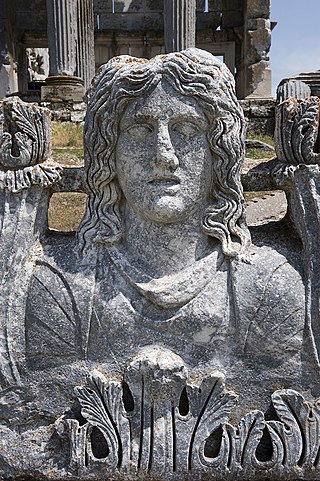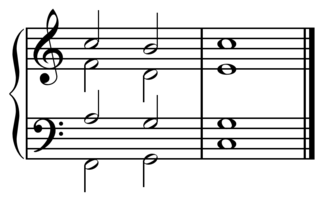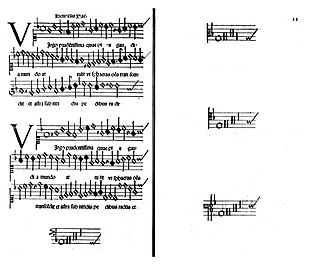
Prophetiae Sibyllarum ("Sibylline Prophecies" or "Sibylline Oracles") are a series of twelve motets by the Franco-Flemish composer Orlando di Lasso. The works are known for their extremely chromatic idiom.

Prophetiae Sibyllarum ("Sibylline Prophecies" or "Sibylline Oracles") are a series of twelve motets by the Franco-Flemish composer Orlando di Lasso. The works are known for their extremely chromatic idiom.
This cycle of motets is said to have been given as a personal gift to Albrecht V. of Bavaria, Lasso's employer, after his arrival in Munich. By the time he had begun work in Germany, Lasso had already enjoyed great success in Italy as a composer for Costantino Castrioto, and was looking to make a new name for himself. The motets were first published in 1600, after Lasso's death in 1594, by his son Rudolph. There remains, however, a small amount of disagreement over the dates of the original manuscript. Boetticher suggests the date to be around 1550–52, during Lasso's time in Naples, while Alfred Einstein prefers a date between 1555 and 1560, by which time Lasso could have seen depictions of the sibyls in places like the Sistine Chapel in Rome, and in the Borgia Apartments of the Vatican. [1]
Crook (1998) claims that the introduction, "Carmina Chromatico", has become, "probably the most analyzed piece of Renaissance music by any composer in any genre," [2] since Lowinsky's 1961 discussion of the prelude's "triadic atonality". [3] This can be understood by studying the Prologue to the cycle. The texture remains triadic, typical of the polyphony of that time, but modulates so often that the listener quickly loses the original tonal center. Lowinsky's discussion has led to other quandaries on the topic of the tonal coherence of the prologue. William J. Mitchell, takes issue with Lowinsky's conclusion and suggests that "perhaps the erosion of any stable tonal center is less the fault of Lasso, who seems to have made a splendid effort, than of the analysis which is indeed atonal." [4] These debates are ultimately built on the question of theorists' license to analyze the piece through our modern lens of tonality and atonality.
The Prophetiae Sibyllarum text is made up of one three-line prologue and twelve six-line motets. All of the poems are in dactylic hexameter. The prophecies, each told by a different prophetess, tell of the coming of Christ. Given the Renaissance's fascination with mysticism and antiquity it is no surprise that Lasso would choose these prophecies as his text. [5] The extremely chromatic setting of this text points toward Lasso's interactions with Cipriano de Rore and Nicola Vicentino, both known for their experiments with chromaticism, during his time at St. John Lateran. Lowinsky also speculates that "rendering the Sibylline prophecies in chromatic style, the young genius probably implied that chromaticism was the music of the future." [6]
Prologue
I. Sibylla Persica
II. Sibylla Libyca
III. Sibylla Delphica
IV. Sibylla Cimmeria
V. Sibylla Samia
VI. Sibylla Cumana
VII. Sibylla Hellaspontica
VIII. Sibylla Phrygia
IX. Sibylla Europaea
X. Sibylla Tiburtina
XI. Sibylla Erythraea
XII. Sibylla Agrippa

Josquin Lebloitte dit des Prez was a composer of High Renaissance music, who is variously described as French or Franco-Flemish. Considered one of the greatest composers of the Renaissance, he was a central figure of the Franco-Flemish School and had a profound influence on the music of 16th-century Europe. Building on the work of his predecessors Guillaume Du Fay and Johannes Ockeghem, he developed a complex style of expressive—and often imitative—movement between independent voices (polyphony) which informs much of his work. He further emphasized the relationship between text and music, and departed from the early Renaissance tendency towards lengthy melismatic lines on a single syllable, preferring to use shorter, repeated motifs between voices. Josquin was a singer, and his compositions are mainly vocal. They include masses, motets and secular chansons.

The sibyls were prophetesses or oracles in Ancient Greece.

Orlando di Lasso was a composer of the late Renaissance. The chief representative of the mature polyphonic style in the Franco-Flemish school, Lassus stands with William Byrd, Giovanni Pierluigi da Palestrina, and Tomás Luis de Victoria as one of the leading composers of the later Renaissance. Immensely prolific, his music varies considerably in style and genres, which gave him unprecedented popularity throughout Europe.

Tonality is the arrangement of pitches and/or chords of a musical work in a hierarchy of perceived relations, stabilities, attractions, and directionality. In this hierarchy the single pitch or triad with the greatest stability is called the tonic. The root of the tonic triad forms the name given to the key, so in the key of C major the tone C can be both the tonic of the scale and the root of the tonic triad. The tonic can be a different tone in the same scale, when the work is said to be in one of the modes of the scale.

A madrigal is a form of secular vocal music most typical of the Renaissance and early Baroque (1600–1750) periods, although revisited by some later European composers. The polyphonic madrigal is unaccompanied, and the number of voices varies from two to eight, but the form usually features three to six voices, whilst the metre of the madrigal varies between two or three tercets, followed by one or two couplets. Unlike verse-repeating strophic forms sung to the same music, most madrigals are through-composed, featuring different music for each stanza of lyrics, whereby the composer expresses the emotions contained in each line and in single words of the poem being sung.
In Christian liturgy, the credo is the Nicene-Constantinopolitan Creed – or its shorter version, the Apostles' Creed – in the Mass, either as a prayer, a spoken text, or sung as Gregorian chant or other musical settings of the Mass.
Chromaticism is a compositional technique interspersing the primary diatonic pitches and chords with other pitches of the chromatic scale. In simple terms, within each octave, diatonic music uses only seven different notes, rather than the twelve available on a standard piano keyboard. Music is chromatic when it uses more than just these seven notes.

Loyset Compère was a Franco-Flemish composer of the Renaissance. Of the same generation as Josquin des Prez, he was one of the most significant composers of motets and chansons of that era, and one of the first musicians to bring the light Italianate Renaissance style to France.
Jean Mouton was a French composer of the Renaissance. He was famous both for his motets, which are among the most refined of the time, and for being the teacher of Adrian Willaert, one of the founders of the Venetian School.
In music history, musica reservata is either a style or a performance practice in a cappella vocal music of the latter half of the 16th century, mainly in Italy and southern Germany, involving refinement, exclusivity, and intense emotional expression of sung text.

The O Antiphons are Magnificat antiphons used at Vespers on the last seven days of Advent in Western Christian traditions. They likely date to sixth-century Italy, when Boethius refers to the text in The Consolation of Philosophy. They subsequently became one of the key musical features of the days leading up to Christmas.
The Lagrime di San Pietro is a cycle of 20 madrigals and a concluding motet by the late Renaissance composer Orlande de Lassus. Written in 1594 for seven voices, it is structured as three sequences of seven compositions. The Lagrime was to be Lassus’ last composition: he dedicated it to Pope Clement VIII on May 24, 1594, three weeks before his death, and it was published in Munich the next year.

Diatonic and chromatic are terms in music theory that are used to characterize scales. The terms are also applied to musical instruments, intervals, chords, notes, musical styles, and kinds of harmony. They are very often used as a pair, especially when applied to contrasting features of the common practice music of the period 1600–1900.

Edward Elias Lowinsky was an American musicologist. Lowinsky was one of the most prominent and influential musicologists in post-World War II America. His 1946 work on the "secret chromatic art" of Renaissance motets was hotly debated in its time, spurring considerable research into the issues of musica ficta and performance practice of early music.

Catholic Marian music shares a trait with some other forms of Christian music in adding another emotional dimension to the process of veneration and in being used in various Marian ceremonies and feasts. Marian music is now an inherent element in many aspects of the veneration of the Blessed Virgin Mary in Catholic Mariology.
Magonia is the name of the cloud realm whence felonious aerial sailors were said to have come, according to commonly-held beliefs denounced in the polemical treatise by Carolingian bishop Agobard of Lyon in 815, where he argues against weather magic. The treatise is titled De Grandine et Tonitruis .
The Unanswered Question is a lecture series given by Leonard Bernstein in the fall of 1973. This series of six lectures was a component of Bernstein's duties as the Charles Eliot Norton Professor of Poetry for the 1972/73 academic year at Harvard University, and is therefore often referred to as the Norton Lectures. The lectures were both recorded on video and printed as a book, titled The Unanswered Question: Six Talks at Harvard.
The Brabant Ensemble is an early music choir based in Oxford, directed by Stephen Rice.

Virgo prudentissima is a six-voice motet (SSAATB), dedicated to the Virgin Mary and composed by Heinrich Isaac in 1507. The motet describes the Assumption of Mary, calling on her and the nine orders of angels to protect Emperor Maximilian I and the Holy Roman Empire. The lyricist was Georg von Slatkonia.